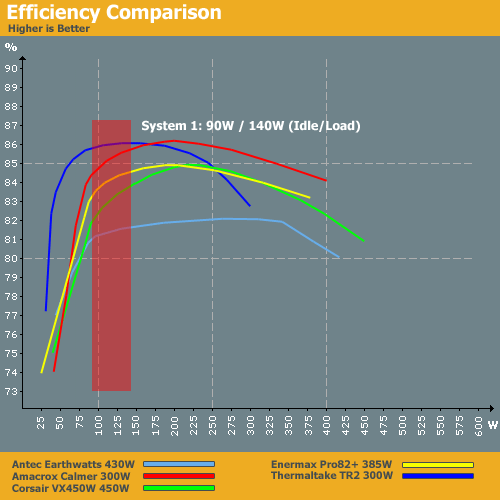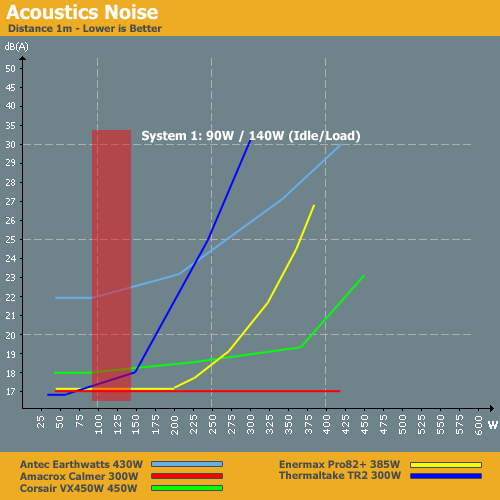Debunking Power Supply Myths
by Christoph Katzer on September 22, 2008 3:00 AM EST- Posted in
- Cases/Cooling/PSUs
Making Compromises
What we have learned from the preceding PSU example? A higher rated power supply will run much quieter if it runs at less than 50% of its rated output, but you don't want the rating to be too high or else efficiency will drop. Now we come to the more complicated part of choosing the right power supply for a new system. You need to make compromises between achieving optimal efficiency and maintaining a quiet working environment. If that is your goal, our high-end sample system is a perfect candidate for a 900W power supply like the Cooler Master UCP 900W. Efficiency is very good throughout the operating range and noise levels will be far lower than the ambient noise from the rest of the system. What we want to do now is go through the three sample systems and select an appropriate power supply.
Our entry-level system has very low power consumption, and unfortunately most power supply manufacturers completely ignore this market segment. Our goal today is to focus on quality power supplies that are readily available worldwide, and most manufacturers start with 500W models and go up from there. That limits our choices, but there are still a few options.
We can only be sure about efficiency if we've tested a power supply, so we will confine ourselves to such units. (Note that we have not necessarily published reviews on all of these power supplies, but we have tested them.) Our entry-level system uses an ATI Radeon HD 3650 graphics card, which means we don't need a PEG connector; that makes our choices a little easier. We'll focus on the following offerings:
- Thermaltake TR2 QFan (300W) actively cooled
- Enermax Pro82+ (385W) actively cooled
- Amacrox Calmer 560 (300W) passively cooled
- Corsair VX450W (450W) actively cooled
- Antec Earthwatts (430W) actively cooled

In the range of 90W to 140W, it's little surprise that the best efficiency is achieved by the two power supplies with the lowest rating (300W). The Thermaltake TR2 QFan places first in our results, and second place goes to the Amacrox Calmer 560. The Enermax takes third place, Corsair is in fourth, and Antec ranks at the bottom of these five options. If it were possible to find a 250W power supply with similar performance at a lower price, that would be even better, but it's just not possible these days. That takes care of efficiency, but let's look at noise levels.

In the same range of 90W to 140W, the Amacrox Calmer 560 and Enermax Pro82+ are the best performers, with the overall crown going to Amacrox, since the Calmer 560 is passively cooled. The Thermaltake TR2 QFan and Corsair VS450W aren't too far behind, at only 18 dB(A) max, while Antec brings up the rear again.
Looking at the above two charts, the Thermaltake TR2 QFan is a perfect candidate for our entry-level system. However, if you instead prefer silence, we would go ahead and pick up the Amacrox Calmer 560. The HD 3650 is also available with passive cooling, so you will never have to complain about computer noise. In fact, I have that exact setup and use it daily as my system for web surfing and writing articles.
As the graphs show, there's still plenty of performance available, so we could even make a few system upgrades down the road. In truth, we could run this sort of system with a 200W power supply, but there are no quality PSUs available in that range. The desire for quality is what led us to select the Amacrox, Thermaltake, Enermax, Corsair, and Antec offerings, as they all provide excellent voltage regulation and overall quality.










98 Comments
View All Comments
7Enigma - Monday, September 22, 2008 - link
20% greater system power? or just for the cpu? If just the CPU what did it equate to system-wise if you don't mind me asking?In an earlier post I mentioned a high-end PSU possibly being better than the mid-grade if you were going to moderately overclock (it was right at the overlap point under heavy load) from a sound and efficiency standpoint. But that was assuming an increase of 20-30% overall.
CK804 - Monday, September 22, 2008 - link
Finally, an article from Anandtech that will really open people's eyes on how much power they actually need.Beenthere - Monday, September 22, 2008 - link
When purchasing a PSU, ignoring the importance of PSU quality and output, in favor of noise and efficiency is foolhardy.Many PSUs do not provide clean power or the rated power - especially under heavy laod. In additional while the article touched on it, depending on the 12V rail design, many PSUs can't deliver the proper power (wattage) to the 12V rail(s) even though the PSU total wattage rating may be more than sufficient . While I'm all for green it is always better to buy a quality PSU that delivers at least 20% more power than you current needs, to provide update headroom and maintain good PSU efficiency and low noise.
If you're not comparing PSU quality, power output per rail and warranty before considering efficiency, noise and cost, then you've missed the point of buying a proper PSU. While most folks do not need a 1000W PSU, many need a quality PSU that can deliver the correct power to each rail and a PSU that will last.
7Enigma - Monday, September 22, 2008 - link
Wouldn't a high efficiency PSU by design be a quality PSU? Generally inferior parts/design are the reason for poor efficiency...mindless1 - Thursday, September 25, 2008 - link
High efficiency doesn't automatically mean high quality per it's own ratings, and an old design not attempting to have high efficiency can still be using reasonably good quality parts and design, unless all your criteria revolve around efficiency being a necessary factor before you'd call a PSU "quality".Take server PSU for example, many don't have such high efficiency but many are higher quality than those used in PCs.
Do you realize that more elaborate filters will reduce efficiency? To some extent, trying to maximize efficiency limits how much quality can be present.
marc1000 - Monday, September 22, 2008 - link
and it is powered by a old Pentium-D 945 (3.4ghz, 90w TDP, and it gets quite hot actually). I also have 1 HDD, 1 DVD-RW, 2GB of ddr2 ram, and one Radeon 3850 512mb.I was in fact using a high-quality 250W PSU, the one that came bundled with the system (I believe it is high-quality because of the build quality and the clear specs, and also because it is a system I bought from HP with "free upgrades option", so I upgraded the CPU+GPU by my own. I wanted a Core2Duo, but my mobo will not accept it.)
whatever. the 250w PSU was working fine, even when I ran old games or 3dmark01. but on 3dmark03/05/06 and newer games, the system was turning itself off after 5 or 10 minutes. so i bought this very quiet AKASA 300w PSU with a single PEG, and now I have a relatively quiet computer that works just fine with no power problems.
this is quite a good gaming machine, if you want to know. I am OK with 20/30 fps, as I am not a hardcore gamer. and I can play GRID at 1680x1050 with almost everything high and 2xAA at this frame rate. also Crysis run fine with everything to medium at this resolution and frame-rate (but this is not so enjoyable because it is a fast-paced FPS). I know that my CPU is the bottleneck, but maybe next year I will change the mobo+CPU.
It is a modest PC, with a modest PSU, for a modest gamer! =)
Insomniac - Monday, September 22, 2008 - link
You said the Corsair VX450W performs best of the low power usage system PSUs. But looking at the charts, it seems the Amacrox Calmer 300W is the best. Its efficiency curve is the highest through the range and its noise curve is the lowest through the range. Was this an oversight or was there a reason this PSU would not work for the midrange system?If it was, that seems like a great PSU. It would be close to the other mid-range PSUs in efficiency and the best for noise. It would be great for a low power system, but has quite a bit of headroom as well.
Christoph Katzer - Monday, September 22, 2008 - link
Since it is passively cooled it has a very limited usability... If you run a few fans it won't be a problem but then you still have the huge price difference between both units.Insomniac - Monday, September 22, 2008 - link
Thanks for the information!duploxxx - Monday, September 22, 2008 - link
Very nice article it really explains the desires and needs what to buy for PSU altough i am missing some top psu's like seasonic for example.Only unfortunate is that some measurements of hardware are way out of range... especially in the motherboard parts.
And if you want to be stay out of who is best... you know the always existing rival that a site has a preferred vendor, take the latest hardware from both sides, if not leave it out.